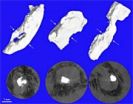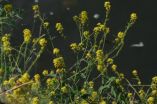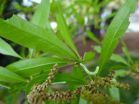(Press-News.org) The bright yellow fields of oilseed rape are a familiar sight at this time of year, but for scientists what lies beneath is just as exciting.
Researchers at the Institute of Food Research are looking at how to turn straw from oilseed rape into biofuel. Preliminary findings are pointing at ways the process could be made more efficient, as well as how the straw itself could be improved.
Straw from crops such as wheat, barley, oats and oilseed rape is seen as a potential source of biomass for second generation biofuel production. Currently the UK produces around 12 million tonnes of straw. Although much is used for animal bedding, mushroom compost and energy generation, there still exists a vast surplus.
Straw contains a mix of sugars that could be used as a source of biofuels that do not compete with food production but instead represent a sustainable way of utilising waste. However, the sugars are in a form that makes them inaccessible to the enzymes that release them for conversion into biofuels, so pre-treatments are needed. The pre-treatments make the complex carbohydrates more accessible to enzymes that convert them to glucose, in a process called saccharification. This is then fermented by yeast into ethanol.
Using the facilities at the Biorefinery Centre on the Norwich Research Park, Professor Keith Waldron and his team have been looking at the steps needed to unlock the sugars tied up in the tough straw structure. In particular, they have looked at the pre-treatment stage, focusing on steam explosion, which involves 'pressure-cooking' the biomass, to drive a number of chemical reactions. A rapid pressure-release then causes the material to be ripped open, to further improve accessibility.
They varied the temperature and duration of steam explosion and then used a variety of physical and biochemical techniques to characterise what effects varying the pre-treatments had on the different types of sugars before and after saccharification.
The amount of cellulose converted to glucose increased with the severity of the pretreatment. Saccharification efficiency is also associated with the loss of specific sugars, and subsequent formation of sugar breakdown products.
In a further study funded by the BBSRC / EPSRC Integrated Biorefining Research and Technology Club, the scientists discovered the key factors that determine the efficiency of saccharification. One particular compound, uronic acid, limited the rate at which enzymes worked. The final sugar yield was closely related to the removal of xylan, a common component of plant cell walls. The abundance of lignin, a 'woody' cell wall component, was positively related to the amount of available sugars.
These findings will help improve the efficiency by which straw can be converted to biofuels. For example, adding enzymes that more effectively remove xylan should improve yield. Controlling the level of lignin in the material should also help.
It may even be possible to improve the straw itself, for example to reduce the uronic acid content in the biomass, as suggested by these findings. In the main, oilseed rape has been bred to improve oilseed yield and disease resistance, without paying much attention to the straw. The IFR is working with colleagues at the University of York and the John Innes Centre to see whether there are ways of breeding more "biofuel-ready" varieties of oilseed rape, with the same yields of oilseed but with more amenable straw. In addition, a full understanding of the polysaccharides and other compounds made available during pretreatment may mean other valuable co-products, like platform chemicals, may be viably produced from the surplus straw.
INFORMATION: END
Straw from oilseed as a new source of biofuels
2014-05-23
ELSE PRESS RELEASES FROM THIS DATE:
Tiny muscles help bats fine-tune flight, stiffen wing skin
2014-05-23
VIDEO:
As bats fly the air pushes their compliant skin around. A new study provides evidence that they control wing stiffness and shape using muscles embedded in their skin.
Click here for more information.
PROVIDENCE, R.I. [Brown University] — A new study of bats reveals a capability within their wondrous wings that may help them fine-tune their flight.
Bats employ a network of nearly hair-thin muscles embedded in the membrane of their inherently floppy wing skin to adjust ...
NASA sees first tropical depression of Eastern Pacific hurricane season
2014-05-23
One week after the official start of hurricane season in the Eastern Pacific Ocean, the first tropical depression was born hundreds of miles southwest of Mexico. NASA's TRMM satellite and NOAA's GOES-West satellites provided looks inside and outside of the depression's clouds. Hurricane season in the Eastern Pacific began officially on May 15.
On May 21 at 22:59 UTC (6:59 p.m. EDT) the Tropical Rainfall Measuring Mission (TRMM) satellite passed over System 92E, which was what Tropical Depression 1E (TD1E) was called before it organized into a depression. TRMM's Precipitation ...
Supernova caught in the act by palomar transient factory
2014-05-23
Supernovae—stellar explosions—are incredibly energetic, dynamic events. It is easy to imagine that they are uncommon, but the universe is a big place and supernovae are actually fairly routine. The problem with observing supernovae is knowing just when and where one is occurring and being able to point a world-class telescope at it in the hours immediately afterward, when precious data about the supernova's progenitor star is available. Fortunately the intermediate Palomar Transient Factory (iPTF) operated by Caltech scans the sky constantly in search of dramatic astrophysical ...
Mapping atherosclerotic arteries: Combined approach developed
2014-05-23
A new method allows calcified and constricted blood vessels to be visualized with micrometer precision, and can be used to design containers for targeted drug delivery. Within the project "NO-stress", materials scientists from the Medical Faculty of the University of Basel combined cutting-edge-imaging techniques to visualize and quantify the constrictions caused by atherosclerosis.
Cardiovascular diseases, including atherosclerosis, are associated with plaque formation and the most prevalent cause of death worldwide. Unlike vessels and other soft tissues, the plaque ...
Risk is much more than a game
2014-05-23
Wildfires and flooding affect many more people in the USA than earthquakes and landslide and yet the dread, the perceived risk, of the latter two is much greater than for those hazards that are more frequent and cause greater loss of life. Research published in the International Journal of Risk Assessment and Management, suggests that a new paradigm for risk assessment is needed so that mitigation plans in the face of natural disasters can be framed appropriately by policy makers and those in the emergency services.
Maura Knutson (nee Hurley) and Ross Corotis of the University ...
The protective milk shot
2014-05-23
Antibodies against C. suis are transferred via the sow's very first milk to the piglets immediately after birth. This was discovered by veterinarian and parasitologist Lukas Schwarz and his colleagues in 2013. These findings prompted the researchers at the Institute for Parasitology to look for a way to increase the level of these antibodies in sows. The ultimate goal was to provide the piglets with as much antibodies as possible via their mother's milk during the first few days of life.
Piglets from infected mothers are healthier
The idea paid off. Piglets from infected ...
Nature inspires drones of the future
2014-05-23
Researchers have been taking tips from nature to build the next generation of flying robots.
Based on the mechanisms adopted by birds, bats, insects and snakes, 14 distinguished research teams have developed solutions to some of the common problems that drones could be faced with when navigating through an urban environment and performing novel tasks for the benefit of society.
Whether this is avoiding obstacles, picking up and delivering items or improving the take-off and landing on tricky surfaces, it is hoped the solutions can lead to the deployment of drones in ...
Rapid evolution aids spread of exotic plant species
2014-05-23
A team of Belgian biologists led by researchers at KU Leuven has provided the first genetic evidence that rapid evolution can help non-native plant species spread in new environments. Using samples of centuries-old herbaria and DNA analysis, the researchers reconstructed the genetic adaptations undergone by the Pyrenean rocket prior to its rapid spread in Belgium.
The Pyrenean rocket (Sisymbrium austriacum subsp. chrysanthum) is a plant that grows in the mountains of southern Europe and is particularly prevalent in the Pyrenees. The species was first reported in Belgium ...
Lack of plant diversity spurs cankerworm damage in cities
2014-05-23
Research from North Carolina State University finds that a lack of plant diversity is a key contributor to the widespread defoliation caused by cankerworms in cities, and highlights the role that increasing diversity can play in limiting future damage.
Fall cankerworms (Alsophila pometaria) are caterpillars that are native to the eastern United States and hatch in early spring. The cankerworms defoliate trees and other plants, eating new leaves as they emerge – which is both unsightly and can ultimately kill the plants.
"We see cankerworms doing more damage to trees ...
Flatland optics with graphene
2014-05-23
Researchers from CIC nanoGUNE, in collaboration with ICFO and Graphenea, introduce a platform technology based on optical antennas for trapping and controlling light with the one-atom-thick material graphene. The experiments show that the dramatically squeezed graphene-guided light can be focused and bent, following the fundamental principles of conventional optics. The work, published yesterday in Science, opens new opportunities for smaller and faster photonic devices and circuits.
Optical circuits and devices could make signal processing and computing much faster. ...







